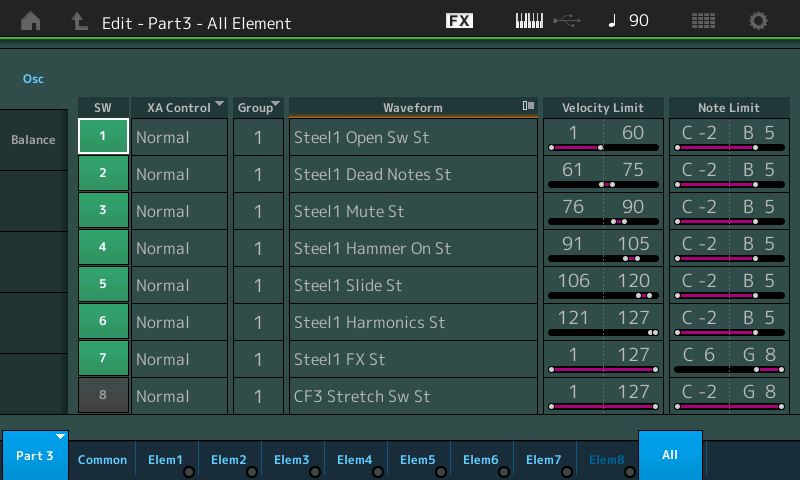I found that with arp switch off in song mode, when I try to record a bass riff or a guitar riff,if I strike the keys to hard I get no sound. If I play the keys with a softer touch they sound fine.I don't seem to have the same problem with piano voices or other keyboard voices.[I can strike these keys harder or softer and get louder to softer response] I hope this describes it better.
My first guess is that in at least one of the elements that form the voice you're using, there's a velocity limit that's set to something like 0-40 (only trigger on soft keying) rather than 0-127 (trigger on any velocity).
The actual elements matter - I know that several of the piano voices use like 5-6 elements , each with a velocity zone set, for covering the range of velocities. So there will be one element set for 0-25, another 26-50, another 51-75 etc up to one that covers to 127. (Yeah, that gotcha puzzled me for most of an evening, only had one element of the set in the voice I was trying to create 🙂
Another thing to check if it's a voice that uses multiple elements for different velocities is whether you've simply managed to disable some of the elements...
If you have the moxf reference manual, the things to check are 'Element Switch' on page 38, and VelocityLimit on page 39. If you hit a key with some velocity N, you won't get a sound unless there's at least one element that has Element Switch 'on', and a VelocityLimit that includes N.
Hope that helps.
thanks, I did explore into what you are suggesting and it loos like that could be it
When you select a PART that uses an Arpeggio... particularly a “Mega” instrument, you will find that they are unplayable by you as a human. Here’s what I mean... most humans (I include myself) think we can control a lot of things that we cannot actually control. Like trying to play a key at a velocity of 75-90 on purpose, on demand, every time. Think you can? Setup a sound with only those velocities and play a C major scale... way harder than you think... imagine in the heat of playing you had to hit a specific key at a specific velocity- Arp Phrases can do it *every time*.
A “Mega” instrument Part (typically guitars and basses) are made from eight different articulations... these can be mapped to specific velocity regions as Valdis describes above... these Mega instruments were specifically designed to use specific Mega Arpeggio Phrases, that can accurately trigger the correct articulation at the appropriate time. Here’s an example using a Mega Steel String Guitar Part with 7 Velocity regioned Elements. You’d have to hit a note in the specific velocity and some times specific key region to get the specific articulation.

The 7 Elements and their Velocity ranges are shown and detailed: (Screenshot showing "All" Elements and their Velocity and Note Limits): taken from the new MONTAGE... it is showing the “Mega Steel Guitar” found in the MOXF PERFORMANCE “Free Fall” in Part 3
Element 1 - Open; the main body of the guitar and the principal strummed notes of the chord.
Element 2 - Dead-note sound.
Element 3 – Mute;
Element 4 - Hammer-On;
Element 5 - Pitch slides that occur in the Phrase;
Element 6 – Harmonic; articulation
Element 7 - FX; the raking noise of the strings being strummed.
In order to perform “open” guitar notes you must squeeze your play into Velocity Range 1-60... the screenshot above is from the MONTAGE, but this is data that comes from the Motif XF and MOXF.
For a deeper discussion of Mega Instrument Parts and Mega Arpeggio Phrases please see this article for an example:
Guitar Arp Study: “Free Fall”
